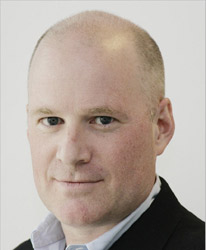COLUMN
America is truly a land of miracles: high profits without investment and low unemployment without wage growth - the economic equivalent of water flowing uphill. Last Friday brought news that, despite the unemployment rate falling to 4.4 percent, the lowest in more than a decade, average hourly earnings only inched up 2.5 percent compared to a year before.
 Wages haven’t risen at a three percent or better clip since 2009, and have spent the entire post-recession period below the rate needed to allow the Federal Reserve to hit its target of two percent inflation.
Wages haven’t risen at a three percent or better clip since 2009, and have spent the entire post-recession period below the rate needed to allow the Federal Reserve to hit its target of two percent inflation.
Wages have been depressed at the very same time that profits have soared: S&P 500 index profits on sales are nearing nine percent, compared to an average of five percent before 1997, according to figures from fund firm GMO.
While economic theory holds that high profits invite investment and competition, it has been quite the opposite. Net investment among nonfinancial firms as a percentage of net operating surplus is now about 60 percent lower than the norm which prevailed in the 1980s and 1990s, according to a recent paper.
These two puzzles - low investment and low wage growth – are not unconnected, and not miracles. They both persist not because economic orthodoxy is wrong, but because theory supposes that firms operate in a competitive market, one in which new firms can rise up, funded by investment, to winnow away the high margins of existing ones.
This would create a demand for labour, and labour at higher wages. Yet the new firms don’t rise up, and the existing ones skimp on investment.
While about 100,000 more firms were born than died each year in the 1998-2007 period, according to Census data, since then net firm births have been just about zero.
But why would any firm pass on profitable new investment? How could they when there are so many others out there just waiting, as the business school professors tell us, to "move their cheese"? Well, maybe not.
“We test eight alternative theories that can explain the investment gap,” Germán Gutiérrez and Thomas Philippon of New York University write in a 2016 study.
“Among these, the only ones that find consistent support in our industry and firm level datasets are decreased competition, tightened governance and, potentially, increased short-termist pressures.”
Wages rise with investment
Firms aren’t investing because they face less competition, something other studies have found is due to regulations which inhibit outsiders, especially in areas like communications and defence.
Indeed, as the NYU paper finds, firms which invest less tend to be owned by institutional investors and may well be responding to pressure to keep quarterly profit figures rising, an issue which matters if you are a fund manager who gets fired if she fails to track the index but which is only weakly correlated to long-term value creation.
These firms which aren’t investing and which only face weak competition are, instead of building new plants, buying back their own shares. This may prop up share prices, at least for a while (See: IBM) but creates only a few jobs for bankers and none for the rest of us.
It is almost certainly also inhibiting productivity growth, which should propel wages. A separate draft study by Philippon and Callum Jones of NYU finds that “Absent the decrease in competition, we find that the US economy would have escaped the zero lower bound by the end of 2010 and that the nominal rate today would be close to 2 percent.”
In other words, we have part of our explanation for secular stagnation, and it is that the US economy has become less competitive.
To be sure, there are other contributing causes, competition from low-cost production globally, and also, at least theoretically, technology. Yet the US has always faced the one and adopted the other, and still wages rose respectably. That is until about 1997.
One of the ironies is that the Federal Reserve, which can do little to foment competition, has responded to the slack in the labour market by keeping interest rates too low and blowing serial bubbles. If there are no jobs in ‘protected’ industries which don’t face competition then we’ll put everyone to work laying marble countertops. The US needs to get to grips with industry concentration, anti-trust and a lack of competition or we’ll continue to be plagued by the twin miracles of abnormal profits and scant wage gains.
The writer is a columnist for Reuters